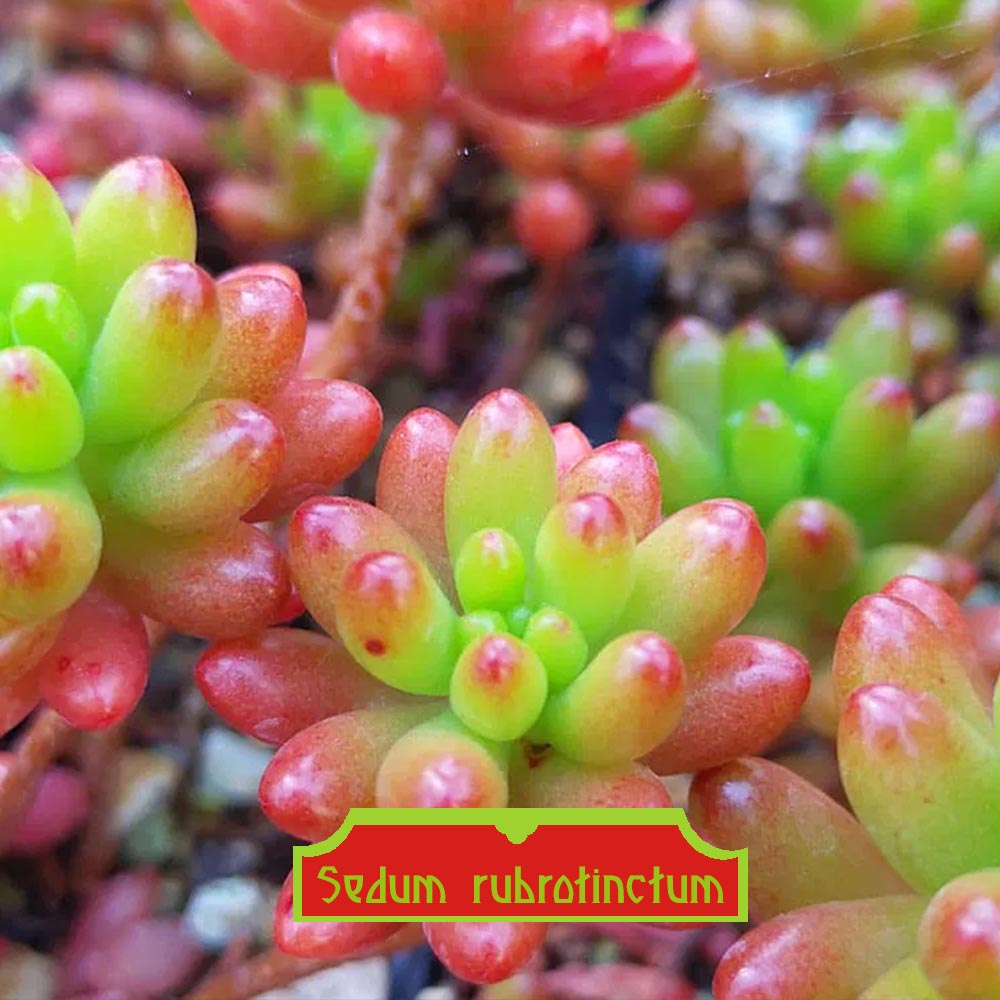No products in the cart.
Sedum rubrotinctum
A color changing plant ideal for sunny interiors.
Rated 0 out of 5
0 customer reviews
4,08 €
Only 5 item(s) left in stock!
Tags: evergreen, feuillage persistant, graphique, plant d'interieur, potted plant, RHS Award of Garden Merit, secheresse
SKU: pda480
Category: Bees and Butterflies, Balcony-Friendly, Bouquet, Evergreen, Ground Cover, Touch of Drama

Sedum rubrotinctum
4,08 €
Only 5 item(s) left in stock!
Sedum rubrotinctum is a particularly beautiful Sedum – color changing, sprawling with bubble shaped leaves, beautiful in hanging pots or sunny balconies.
The leaves of Sedum rubrotinctum are small, shiny, fleshy, cylindrical that resemble plump grains of rice.
Similar to other sedums, the leaves have a color-shifting ability though it is triggered by the amount of sun that the plant is exposed to.
The more sun the plant receives, the more red the leaves will appear.
Both the stems and the leaves are capable of produces roots when they come into contact with soil – so don’t worry if the leaves detach! They are similar to the Sedum morganianum in this way – they will form new plantlets if you leave them be.
In winter, star-shaped yellow flowers with five petals appear.
👨🌾GARDENING TIP👨🌾: Sedum rubrotinctum
-
- These look magnificent when grown in a pot – they drape and they flow (this also makes it easier to bring them in when the temperatures drop). Water once a month.
- Specificities? Well-drained substrate and lots and lots and lots of sun.
Learn more about caring for your Sedum groundcover!
The Tales & The Botany: Sedum rubrotinctum
This variety is the result of a hybridization between Sedum pachyphyllum and Sedum stahlii.
As this variety is from Mexico, it is not very hardy in our region – tolerating frosts only down to -5°C (23°F).
🌸 Floral Morphology
Sedum rubrotinctum is a succulent in the Crassulaceae family, forming dense, low-growing mats of fleshy, cylindrical leaves that are bright green and often tipped with red under sun exposure.
The plant produces small, star-shaped, yellow flowers arranged in loose clusters (cymes) that typically bloom in late winter to spring.
Flowers are actinomorphic and hermaphroditic, with five sepals and five petals, and a superior ovary. The compact, fleshy leaves serve as water storage organs, enabling the plant to withstand drought conditions.
🧬 Reproductive Biology
Pollination is primarily entomophilous, attracting bees and other small insects. Sedum rubrotinctum propagates easily through leaf cuttings or stem offsets, allowing rapid vegetative reproduction.
Seeds are produced in small capsules but vegetative propagation is far more common in cultivation.
The plant exhibits Crassulacean Acid Metabolism (CAM), opening stomata at night to conserve water while allowing photosynthesis during the day.
🦋 Ecology & Cultivation
Sedum rubrotinctum thrives in well-drained, sandy or rocky soils under full sun, although it tolerates light shade.
It is drought-tolerant, frost-sensitive, and well-suited for rock gardens, containers, or as ground cover.
The plant is low-maintenance, requires minimal watering, and benefits from occasional pruning to remove damaged or overgrown stems.
Its vibrant leaf colors and compact growth habit make it popular for ornamental gardening and succulent collections.
Other names:
Jelly-beans
Pork and beans
Origin:
Mexico
| Weight | 0,5 kg |
|---|---|
| Flowering | June, July, August |
| Exposure | Full Sun |
| Frost Tolerance | -5°C to -10°C |
| Size | 0.2m H x 0.5m W |
| Soil | Loam, Dry, Sandy, Well-Draining |
Reviews
0
Rated 0 out of 5
0 customer reviews
5
0
4
0
3
0
2
0
1
0
Only logged in customers who have purchased this product may leave a review.
You may also like…
Sedum morganianum ‘Burrito’
A lovely succulent that develops thick trailing stems covered with overlapping, plump, blue-green leaves as it grows.
A lovely succulent that develops thick trailing stems covered with overlapping, plump, blue-green leaves as it grows.
Rated 0 out of 5
Tradescantia fluminensis Yellow Hill
A fast-growing, sprawling tropical perennial with random, mottled yellow and green variegation.
A fast-growing, sprawling tropical perennial with random, mottled yellow and green variegation.
Rated 0 out of 5
Kalanchoe pumila
A silver succulent that forms a small, clumping bush.
A silver succulent that forms a small, clumping bush.
Rated 0 out of 5
Tradescantia fluminensis White Giant
A Tradescantia with compact stems and fairly large white and silvery green variegated leaves.
A Tradescantia with compact stems and fairly large white and silvery green variegated leaves.
Rated 0 out of 5
Related Products
Stachys byzantina
Silky white-grey leaves and tall striking flowers
Silky white-grey leaves and tall striking flowers
Rated 0 out of 5
Tanacetum densum subsp amani
A shrublet composed of soft, finely divided silvery gray-white leaves.
A shrublet composed of soft, finely divided silvery gray-white leaves.
Rated 0 out of 5
Cerastium tomentosum var. columnae
A grey-green spreading ground cover from the mountains.
A grey-green spreading ground cover from the mountains.
Rated 0 out of 5
Kalanchoe daigremontiana
A toothy succulent from Madagascar, known as the Mother of Thousands.
A toothy succulent from Madagascar, known as the Mother of Thousands.
Rated 0 out of 5
Hellebore argutifolius
Winter flowering perennial with marbled blue-green leaves
Winter flowering perennial with marbled blue-green leaves
Rated 0 out of 5
Artemisia Valerie Finnis
A semi-evergreen, aromatic variation on the theme of Artemisia.
A semi-evergreen, aromatic variation on the theme of Artemisia.
Rated 0 out of 5
Sedum album
A low, multi-color ground cover.
A low, multi-color ground cover.
Rated 0 out of 5
Melissa officinalis
A perennial plant in the mint family that is adored by bees, royal families and tea drinkers.
A perennial plant in the mint family that is adored by bees, royal families and tea drinkers.
Rated 0 out of 5
Vinca minor
Looping elegance and ability to form a low flowering ground cover
Looping elegance and ability to form a low flowering ground cover
Rated 0 out of 5
Delosperma cooperi
A dwarf perennial known for its vermillion colored flowers
A dwarf perennial known for its vermillion colored flowers
Rated 0 out of 5
Mentha x piperita ‘Chartreuse’
A spicy mint, known for its use in the production of liqueurs and herbal teas.
A spicy mint, known for its use in the production of liqueurs and herbal teas.
Rated 0 out of 5
Echinacea purpurea
A perennial with purple flowers all summer long
A perennial with purple flowers all summer long
Rated 0 out of 5
Euphorbia myrsinites
Known for its draping form of silver-gray foliage and radiant blooms.
Known for its draping form of silver-gray foliage and radiant blooms.
Rated 0 out of 5
Trachelospermum asiaticum ‘Ogon Nishiki’
Jasmine with colorful foliage and lovely white flowers in summer
Jasmine with colorful foliage and lovely white flowers in summer
Rated 0 out of 5
Hieracium maculatum Leopard
A native perennial with blue-green leaves and a tall yellow flower
A native perennial with blue-green leaves and a tall yellow flower
Rated 0 out of 5
Tradescantia Blushing Bride
Gorgeous blushes of pink and white that appear in the coldest nights.
Gorgeous blushes of pink and white that appear in the coldest nights.
Rated 0 out of 5
Erigeron kavinskianus
A daisy-like carpet of flowers
A daisy-like carpet of flowers
Rated 0 out of 5
Euphorbia cyparissias Clarice Howard
A Euphorbia that resembles a soft little cyprus tree
A Euphorbia that resembles a soft little cyprus tree
Rated 0 out of 5
recent view product
Coreopsis verticillata ‘Zagreb’
A perennial coreopsis that forms a compact clump, covered with small golden-yellow flowers
A perennial coreopsis that forms a compact clump, covered with small golden-yellow flowers
Rated 0 out of 5
Tanacetum balsamita
A perennial known for its distinctively aromatic foliage and tiny yellow flowers
A perennial known for its distinctively aromatic foliage and tiny yellow flowers
Rated 0 out of 5
Allium senescens subsp. montanum
Mountain garlic with pink pompom flowers
Mountain garlic with pink pompom flowers
Rated 0 out of 5
Tradescantia fluminensis Yellow Hill
A fast-growing, sprawling tropical perennial with random, mottled yellow and green variegation.
A fast-growing, sprawling tropical perennial with random, mottled yellow and green variegation.
Rated 0 out of 5
Satureja montana
A sweet smelling culinary herb from Europe
A sweet smelling culinary herb from Europe
Rated 0 out of 5





















































There are no reviews yet.